Putting: Aimline
Putting has a lot of myths and misunderstandings that need to be dispelled. One that I consistently see is an incorrect perception of the start line of a putt. Almost no one outside of pros and low handicappers understands how a ball actually rolls and breaks when putting. Because of this misunderstanding, they consistently underread putts or make compensations in their stroke. I want to break down the roll of a putt, in detail, so you can start aiming better and making more putts. Let’s go.
Terms
Let’s clarify a few terms first, so we’re all on the same page:
- Apex
- The furthest point on the ball’s path of travel from the imaginary line that runs from the ball directly to the center of the hole.
- Aimline
- The straight line through the ball out into space where a putt struck dead straight with the correct speed will break into the hole.
The relationship between these two concepts is key to all that we are about to learn.
How does a putt actually roll?
Every putt, no matter how short or long, rolls in two distinct phases: the launch phase and the roll phase. Understanding these two phases is key to proper aim.
Launch phase
When a putt is struck, even short ones, the ball is launched into the air. Literally. You can see this on slow motion video. The loft of the putter launches the ball slightly into the air, helping it out of whatever microscopic depression it was sitting in (a ball always comes to rest in a depression due to gravity).
While the ball is in the air, it has spin, just like every other shot in golf (you shouldn’t be too concerned about this fact, it’s just good knowledge to have). There’s even a chance on very long putts that the ball has some significant backspin. This is why I also call this phase of the ball’s roll the skid phase. Actively listen the next time you hit a really long putt. See if you can hear the “tss tss tss” of the ball skidding for the first few feet. Notice how long it skids before rolling. You can also see this early in the morning on a dewy green. You’ll see little skips where the ball didn’t contact the surface while it was skidding.
As the ball launches (and skids), it is not yet into its roll. For the duration of this phase (which is extremely small on short putts, and perhaps a few inches to a few feet on very long ones), the ball travels in a straight line based upon launch path. Once it finishes launching, it begins the roll phase.
Roll phase
The roll phase begins when the ball starts to roll end-over-end. As soon as it starts rolling, and I cannot emphasize this enough, the ball begins to break.
Let me repeat that because it’s so important: as soon as it starts rolling the ball begins to break.
Why is it breaking so soon? It’s simple. Gravity.
Gravity is always acting upon the ball, but while the ball is launching, the influence of the slope doesn’t yet affect the ball. How could it when it’s not in contact with the ground consistently yet?
However, once the ball is on the ground and rolling, the downward pull of gravity will start to cause the ball to break. This means that as the ball approaches the apex, it has already been breaking to get there, often quite a bit.
Understand, most people conceive of a putt traveling dead straight to the apex and then making a turn towards the hole, but this is wrong. It’s just not how physics work.
Yes, it’s true that the ball will break less at the start of its journey than at the end due to the greater initial speed of the putt, but that doesn’t mean it fails to break at all. The moment it starts rolling, gravity is pulling that ball down to the lowest point it can.
This means that almost everyone who tries to aim at the apex is aiming well below the actual aimline. They have failed to perceive many feet of travel where the ball was already breaking. Here’s a diagram I made to demonstrate this:

If you aim directly at the apex as many people do, then the only chance you have of making that putt is one of the following ways:
- The putt is straight enough that there isn’t enough of a difference between the aimline and the line through the apex to miss
- The putt is hit with the incorrect speed (too hard)
- A compensation in the stroke is made to get the ball closer to the correct aimline
The fix
The best drill I know for improving your ability to visualize and aim down the correct aimline is to get a putting string line.
A string line is a simple training aid: just a thin string between two posts. You can even make one. I’ve done it with yarn and chopsticks. It really doesn’t need to be fancy (though there are fancy ones you can buy).
To use the string line, find a breaking putt on the practice green and place one of the posts behind where you intend to set the ball. Be sure to give yourself enough room to take the proper backswing for the putt you’ve chosen.
Next, place the other post as far down the aimline as possible. You want the string to be taut, creating a straight line that will run through the ball out to where you might aim.
Then, hit putts placing the ball directly under the string and putting down the string line. Adjust the string until you’re able to hit a putt straight down the line and hole it with the correct speed (about 18 inches past the hole). Your goal is to launch your putt on the line, but remember, the ball will only stay under the string for a very short period of travel. You’ll see just how quickly it starts to break to the low side of the string.
For added visual feedback, you can identify the apex of the putt in some way. You can use a “ghost hole”, a flat disc the size of a hole, to watch the ball roll over. Another option, I often will place tees or coins left and right of the apex point as a gate. The idea is to train your brain to see the aimline above the apex, and how those two relate on different breaking putts.
Be sure to practice this drill on right-to-left and left-to-right putts. You may learn you have been making compensations in your stroke for different breaks and you’ll need to break that habit to hit it down the line.
Hopefully this drill trains you to start recognizing the actual aimline of your putts and gets you holing a few more.
Additional benefits
There are additional benefits that come from learning to aim down the correct aimline. Here are a few:
Better speed
Often, when people start to aim better, their speed gets a lot better, too.
By recognizing the full break of a putt and aiming better, you naturally stop needing to make speed compensations to try and hole a putt. Essentially, you stop needing to hit it at a speed that goes well past the hole to try and hold the incorrect line. Instead, you’re able to trust gravity to do its job and pull the ball to the hole, which frees you up to hit the putt at the correct speed.
Closer misses
Because people tend to aim low and then compensate with speed, when they miss, the ball is already on the low side and running further away from the hole. Even with the correct speed, underreading a putt can quickly lead to a few extra feet on a comebacker.
By playing closer to the true aimline, you’ll effectively shift your margin of error from being strictly below the hole to split above and below the hole. Rather than having 3-4 footers from the low side, you’ll have more 1-2 footers on both sides of the hole. There’s a good chance you’ll three-putt less often with better aim.
Summary
The ball starts breaking as soon as it starts rolling end over end, which means its breaking into the apex, placing the correct aimline well above the apex. Seeing the proper aimline will help us hole more putts and make fewer compensations.
